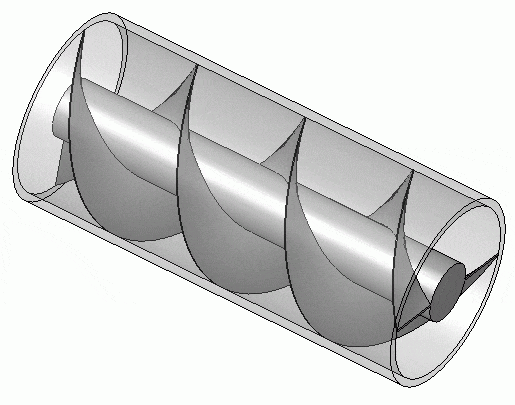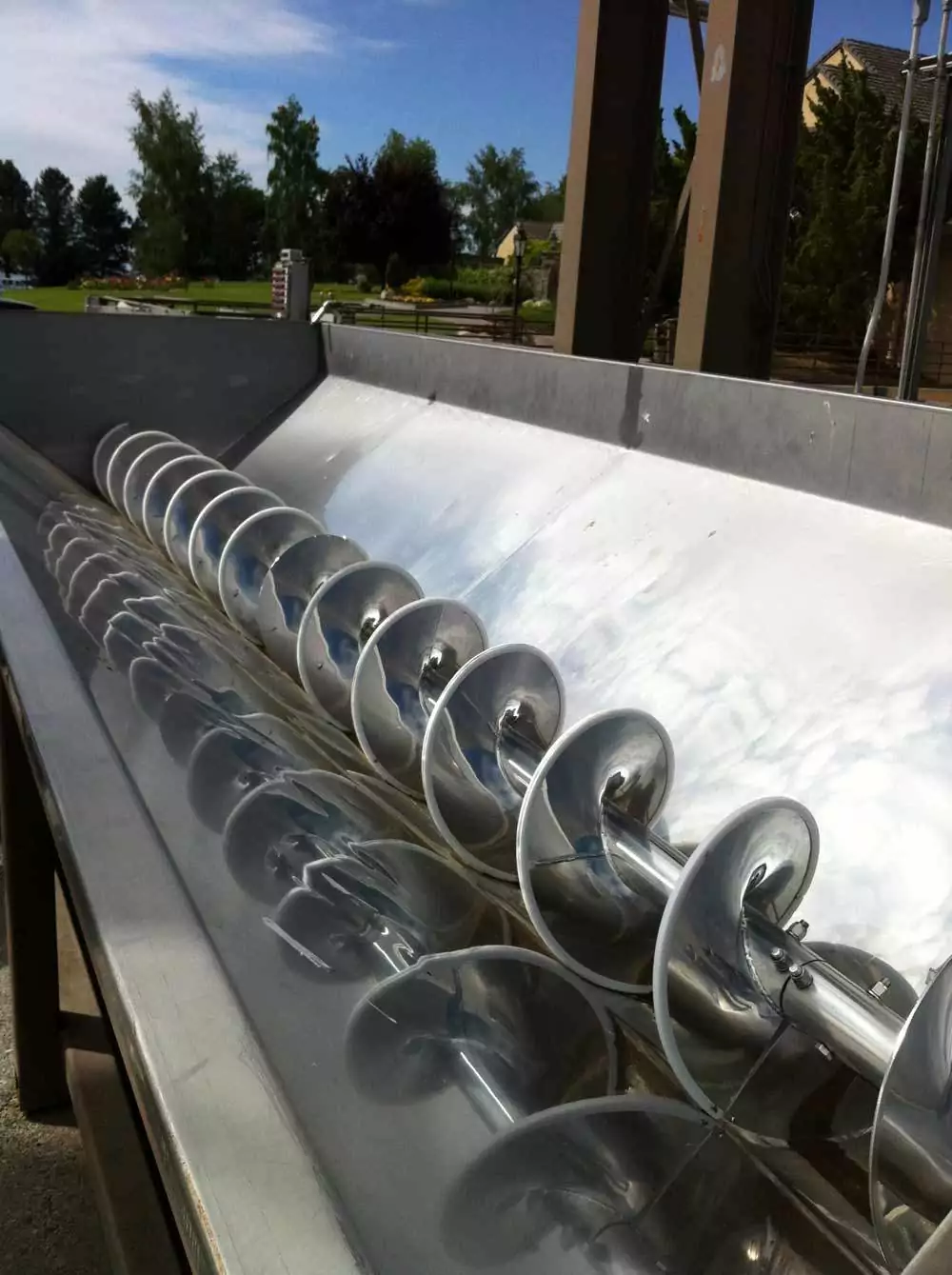Transport systems are needed in warehouses to transport goods. For this purpose, there are various possibilities for different requirements in conveyor technology. In addition to roller, vibratory and circular conveyors, screw conveyors (also known as Archimedes’ spiral or conveyor spiral) also belong to the category of continuous conveyors. Continuous conveyors are characterized by the fact that goods are conveyed with a continuously generated transport stream. In a screw conveyor, goods are transported with a rotating screw, often made of steel. They flow through one, often flexible, pipe, from one or more receiving points to one or more delivery points. A screw conveyor transports the corresponding material horizontally, vertically or diagonally over several meters.
The screw conveyor is designed in such a way that a screw conveyor is driven in a trough and the material to be conveyed is fed and discharged at corresponding inlets and outlets. Unlike a spiral conveyor, the screw conveyor has a worm shaft in the middle.
The screw conveyor and its operation
The force of gravity and the friction of the transported goods against the trough walls ensure that the goods do not rotate with the screw conveyor, but are permanently transported further. The effective and also efficient transport depends on the degree of filling, which must not be too high, otherwise the friction on the wall is too low. An important criterion for vertical transport is the speed of rotation, as it generates the necessary centrifugal force that makes friction possible. This requires high speeds of 250 to 400 revolutions per minute (min-1). This is also referred to as the rotation frequency. For comparison: The main rotor of a helicopter usually reaches a speed of 400 min-1, whereas a diesel engine reaches about 5,000 min-1 (source: Wikipedia).
A screw conveyor is a conveyor system which, as mentioned above, transports goods according to the Archimedean screw principle. The image of a conveying system with a flexible screw is to illustrate how a conveying spiral works. The suction pipe of a screw conveyor can be used as a hopper due to its U-shaped loading chute.

The material to be conveyed flows from above into the loading chute through the flexible conveying spiral. The spiral centres itself automatically within the pipe. There is a small gap between the spiral and the pipe wall. In this way, goods can flow through the screw conveyor without damage and grinding or crushing of the material is avoided.
With flexible conveying spirals, goods can be conveyed quickly and evenly at a high speed through a flexible spiral. The screw conveyor is usually driven by a motor. The pipe in which the spiral is located is usually made of plastic or steel. Goods can also be transported in rigid pipes. In contrast to the flexible screw, rigid screws do not have any bending in the pipe. A rigid screw therefore has a reduced flexibility in the use of space.

Continuous conveyors are mechanical, pneumatic and hydraulic conveying systems in which the material to be conveyed is moved continuously, at varying speeds or in cycles along a defined conveying path from feed to discharge point. They are designed to be stationary, mobile or shiftable and are used for conveying bulk material or general cargo.
DIN 15201, T1
During inclined, vertical or horizontal transport, further processing steps such as portioning, mixing, dewatering, compressing, cooling or drying can be applied in parallel. The RPM, the inner and outer diameter, the pitch, the degree of filling and the friction of the conveyed material on the screw determine the flow rate. Their maximum is reached when the friction at the screw conveyor is smaller than the friction at the trough wall.
Important: A decisive factor in the design of a screw is the expected filling level over the process length. The pitch of the screw and the channel depth are the main factors in calculating the filling level; the greater the pitch, the higher the filling level.
Screw conveyors and their designs
Depending on the task and product characteristics, there are single-shaft and twin-shaft screw systems. For continuous mixing and crushing, mainly twin screw conveyors are built. If the vertical, horizontal or inclined conveying path is curved, spiral conveyors are usually used.
Known designs of a screw conveyor are:
- Full auger
- Band auger
- Stirring screw
- Paddle auger
Conveying lengths of a few metres are just as much a part of day-to-day operations as are conveying lengths of over sixty metres, which are realised by means of intermediate storage. A special feature is the geometry of extruders and meat grinders. There the helix is constructed in such a way that the cross-section narrows towards the outlet, thus generating high pressures that force rather tough material through templates or into moulds.
Use
Screw conveyors are particularly suitable for conveying liquids, granulates and powders and are used for example in grain silos or in the production of pellets. They also play an important role in the production of plastics, as so-called extruders, at the end of which the plastic pieces are pressed out, in the same way that coarse pieces of meat are processed into minced meat in a mincer.
Screw Conveyor – Summary
A screw conveyor is used, for example, to transport so-called bulk material. The screw conveyor is rigid and permanently installed. It consists of rotating screw conveyors that move inside a trough or tube. “As a modification of this most used standard version, the screw conveyor can also be designed with double helix, conical helix or helix with variable screw pitch. Special forms are the paddle screw, in which the helix is replaced by individual paddles, the band screw, in which the screw helix is designed as a belt attached to the shaft with webs, and the spiral conveyor, in which the shaft is missing [VDI 2330]. The bowl feeder is also known in flexible design [Kun-1983, Sch-1989a]. Another special design is the screw tube conveyor. In this case, the helix is attached to the delivery pipe, which now rotates*. Screw conveyors are particularly in demand in the plastics industry, food industry and in the building materials industry. This is because they are particularly suitable for the transport of goods that are difficult to transport, such as food or bulk goods.
*Stefan Rakitsch, Dimensionierung und Auslegung stark geneigter Schneckenförderer / Dissertation / Page 2
Teaser image: Chong Fat / gemeinfrei
Archimedic spiral: Author: Silberwolf, Bild-Lizenz: CC-BY-SA-2.5
Also available in Deutsch (German)